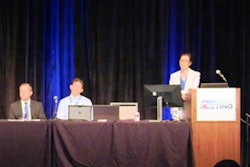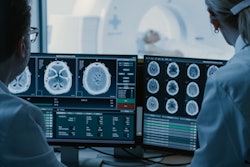
Faced with sharply lower imaging volumes in the onset of the COVID-19 pandemic, most radiology practices in the U.S. were forced to adopt cost-cutting measures such as reducing headcount, salaries, and incentive payments, according to research published online August 4 in the Journal of the American College of Radiology.
Nearly all practices reported performing fewer imaging studies -- as much as 63.7% less -- according to a survey conducted in April of members of the American College of Radiology (ACR) and the Radiology Business Management Association (RBMA).
What's more, practices reported that gross charges and collections were cut approximately in half. These declines were not correlated with the size of the radiology practice.
"Radiology practices across different settings experienced substantial declines in imaging volumes and collections during the initial wave of the COVID-19 pandemic in April 2020," wrote a team of researchers led by Dr. Ajay Malhotra of the Yale School of Medicine. "Most are actively engaged in both short- and long-term operational adjustments."
The 242 practices that responded to the survey included 75 hospital-based organizations, 24 imaging centers, 62 mixed practices, and 17 breast centers/others.
| Financial impact of COVID-19 pandemic on radiology practices in April 2020 | ||||
| Hospital-based organizations | Imaging Centers | Mixed practices | Breast centers/others | |
| Percentage of practices that had lower revenue | 96% | 100% | 100% | 94% |
| Mean change in receipts | -47.3% | -53.9% | -51.2% | -46.4% |
| Mean change in gross charges | -52.6% | -54.8% | -54.1% | -50.1% |
Of the respondents, 164 reported that they had applied for financial relief programs, with most applying for two or more such programs. Furthermore, 145 (87%) of 167 respondents said that they had experienced a reduction of salary and/or headcount. Over half of practices had either reduced, postponed, or eliminated incentive payments, according to the researchers.
Also, 111 (62.3%) of 170 responders indicated that they had existing remote reading or teleradiology capabilities in place prior to the pandemic, while 22.3% implemented those capabilities in response to the pandemic.
In addition, 114 (77%) of 148 respondents agreed that remote reading/teleradiology would likely be standard operating procedure in the future, while 50.7% believed that onsite reading would only be utilized to maintain visibility and availability.
Of the 147 respondents who answered the question about COVID-19 testing among radiologists, 23 (15.6%) said that radiologists in their practice had tested positive. A total of 41 radiologists were positive for COVID-19, 37 of whom were symptomatic.
In other findings, the majority of respondents believed that imaging volume would recover in the future, but not entirely; imaging centers had the lowest proportion (62.5%) who felt that way, while hospital-based organizations had the highest (88%). More than half (range of 52% to 64%) of respondents stated that there may be a short-term surge due to postponement of elective imaging, with breast centers/others having the highest proportion.
"The continued spread in parts of the U.S. and possibility of further increases in parts previously affected adversely make prediction of the short- to medium-term impact unclear," the authors wrote.
The researchers noted that they hope to conduct a follow-up survey to further study these issues.



















